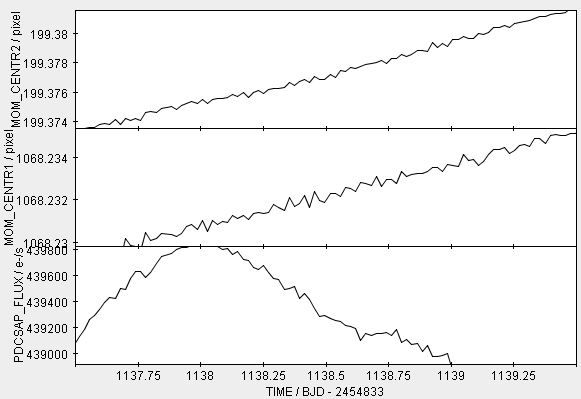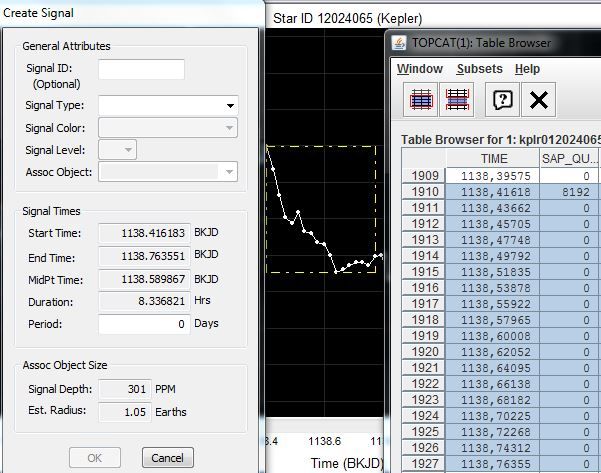KIC 12024065: possible Earth analog
-
 by
ajamyajax
by
ajamyajax
Certainly speculative, but also tantalizing as a possible Earth analog in my view -- with a possible p=333.x day transit here. A few gaps, but still three transits of similar duration of around 10 hours. From what I spotted on a quick internet search, it takes up to 12 hours for Earth to transit the Sun when seen from a distance.
possible epoch/period/duration
s1=138.25 p1=333.45 d1=0.42 (10.08 hrs)
...




Posted
-
 by
Artman40
by
Artman40
What might be the most common false positive scenario?
Posted
-
 by
ajamyajax
in response to artman40's comment.
by
ajamyajax
in response to artman40's comment.
From what I have seen in several years of doing this, there is more than one common cause. Recently there are more details on why a KOI list entry is considered a FALSE POSITIVE. This is new however, so not all these records are updated yet.
But here are the new flags and you can read a bit more about each of them in the link below.
koi_fpflag_nt, Non-Transit-Like Flag
koi_fpflag_ss, Significant Secondary Flag
koi_fpflag_co, Centroid Offset Flag
koi_fpflag_ec, Ephemeris Match Indicates Contamination Flaghttp://exoplanetarchive.ipac.caltech.edu/docs/API_kepcandidate_columns.html#transit_fit_param
Hope this helps.
Posted
-
 by
JKD
by
JKD
@ ajamyajax
Indeed, this might be a new PC.
Very good observation!
br JKDPosted
-
You could be right. APO seems fine and SAP_QUALITY only shows one impact of cosmic rays:
APO:

SAP_QUALITY:

Posted
-
 by
Shellface
by
Shellface
Here are the KIC parameters and the SIMBAD result. The parameters are indicative of an early M-dwarf, around M0-M2 V, and its distance is ~250 lya,
With that in mind, the semi-major axis of a 333-day planet around a 0.56 M☉ star is 0.78 AU, but the HZ is at ~(0.25-0.50) AU, so this cannot be considered an Earth-like planet. It also strikes me that a 10-hour transit is rather long for a 333-day planet around a 0.56 R☉ star, though I don't have the equations to hand.
Nevertheless, this does seem like a very interesting candidate! I'd like to see this investigated some more.
Posted
-
 by
Artman40
by
Artman40
But aren't ice planets even harder to find than Earth analogues?
Posted
-
 by
ajamyajax
in response to Shellface's comment.
by
ajamyajax
in response to Shellface's comment.
Thanks, appreciate your input. And I should have thought of that. So I guess now we have to hope for a little help in two areas: a) some support the transit is real, of course, and b) the star's radius is revised and increased to at least 0.8X Sol.
I did use the most recent NEA star radius value of 0.623X Sol to get the 0.82 Re planet radius estimate on my fitted chart.. So an increase there would help in the Earth radius comparison also. But that is probably just wishful thinking.
So thanks again for your earlier HZ assessment. Onwards and upwards.
p.s. just one more hopeful thought: maybe the observed 10-hour duration supports a possibly larger star here.
Posted
-
 by
ajamyajax
in response to Martti Holst Kristiansen's comment.
by
ajamyajax
in response to Martti Holst Kristiansen's comment.
Also thanks for your charts and to others for their comments. I always appreciate another person's technical views or opinions, whether their conclusion is positive or negative. It's all a healthy part of the process.
Edit: and I do look at yours and others candidates when I can (usually need something periodic to chart though).
Posted
-
 by
Shellface
by
Shellface
@artman40 : More difficult to detect, yeah. That's what makes this so potentially valuable.
@ajamyajax : It is… likely futile to hope for the star's radius to be estimated as much larger than 0.6 R☉, as its spectral type is consistent for both the star's colours and its photometric parameters and M-dwarfs occupy a very narrow region of the temperature-radius diagram. A radius of ~0.75 R⊕ is likely to be unchanging.
So I think it's best that comparisons to Earth should be stopped. This candidate is very interesting in its own right, because there are very few small, cold planets or candidates known. If all sensible false positive scenarios can be excluded, then this could turn out to be an extremely valuable transiting system.
Posted
-
 by
ajamyajax
in response to Shellface's comment.
by
ajamyajax
in response to Shellface's comment.
Fair enough, thank you.
Posted
-
 by
Martti_Holst_Kristiansen
in response to ajamyajax's comment.
by
Martti_Holst_Kristiansen
in response to ajamyajax's comment.
You are welcome. Do you mind posting the exact intervals of the three features? I will then create more accurate charts.
Feel free to post on this one: http://talk.planethunters.org/#/boards/BPH0000008/discussions/DPH00004ac , and thank you!
Posted
-
Using the following properties for a 10.08 hours duration: flux [0.000423-0.000691], kepmag 11.162, teff 3885, radius 0.555, mass of star 0.79, I get a period of ~ 555.9 days. This seems a bit off, but when applying a new transit duration regarding my previous post (8.33 hours) and using the same properties as before I now get a period of 314.5 days which seems more adapted to the 333.45 period.
Posted
-
 by
Shellface
in response to Martti Holst Kristiansen's comment.
by
Shellface
in response to Martti Holst Kristiansen's comment.
Given a plausible error for that transit length, I'd say the predicted period is now consistent with the observed one. That's rather convincing! This is definitely a viable-looking candidate.
Posted